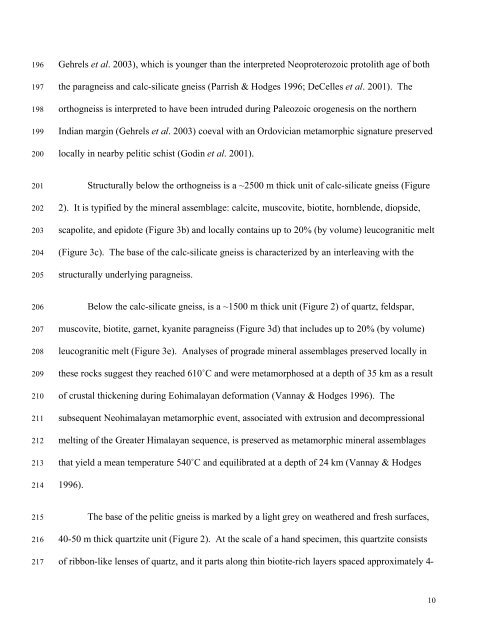Kinematics of the Greater Himalayan sequence, Dhaulagiri Himal ...
Kinematics of the Greater Himalayan sequence, Dhaulagiri Himal ...
Kinematics of the Greater Himalayan sequence, Dhaulagiri Himal ...
Create successful ePaper yourself
Turn your PDF publications into a flip-book with our unique Google optimized e-Paper software.
196<br />
197<br />
198<br />
199<br />
200<br />
Gehrels et al. 2003), which is younger than <strong>the</strong> interpreted Neoproterozoic protolith age <strong>of</strong> both<br />
<strong>the</strong> paragneiss and calc-silicate gneiss (Parrish & Hodges 1996; DeCelles et al. 2001). The<br />
orthogneiss is interpreted to have been intruded during Paleozoic orogenesis on <strong>the</strong> nor<strong>the</strong>rn<br />
Indian margin (Gehrels et al. 2003) coeval with an Ordovician metamorphic signature preserved<br />
locally in nearby pelitic schist (Godin et al. 2001).<br />
201<br />
202<br />
203<br />
204<br />
205<br />
Structurally below <strong>the</strong> orthogneiss is a ~2500 m thick unit <strong>of</strong> calc-silicate gneiss (Figure<br />
2). It is typified by <strong>the</strong> mineral assemblage: calcite, muscovite, biotite, hornblende, diopside,<br />
scapolite, and epidote (Figure 3b) and locally contains up to 20% (by volume) leucogranitic melt<br />
(Figure 3c). The base <strong>of</strong> <strong>the</strong> calc-silicate gneiss is characterized by an interleaving with <strong>the</strong><br />
structurally underlying paragneiss.<br />
206<br />
207<br />
208<br />
209<br />
210<br />
211<br />
212<br />
213<br />
214<br />
Below <strong>the</strong> calc-silicate gneiss, is a ~1500 m thick unit (Figure 2) <strong>of</strong> quartz, feldspar,<br />
muscovite, biotite, garnet, kyanite paragneiss (Figure 3d) that includes up to 20% (by volume)<br />
leucogranitic melt (Figure 3e). Analyses <strong>of</strong> prograde mineral assemblages preserved locally in<br />
<strong>the</strong>se rocks suggest <strong>the</strong>y reached 610˚C and were metamorphosed at a depth <strong>of</strong> 35 km as a result<br />
<strong>of</strong> crustal thickening during Eohimalayan deformation (Vannay & Hodges 1996). The<br />
subsequent Neohimalayan metamorphic event, associated with extrusion and decompressional<br />
melting <strong>of</strong> <strong>the</strong> <strong>Greater</strong> <strong><strong>Himal</strong>ayan</strong> <strong>sequence</strong>, is preserved as metamorphic mineral assemblages<br />
that yield a mean temperature 540˚C and equilibrated at a depth <strong>of</strong> 24 km (Vannay & Hodges<br />
1996).<br />
215<br />
216<br />
217<br />
The base <strong>of</strong> <strong>the</strong> pelitic gneiss is marked by a light grey on wea<strong>the</strong>red and fresh surfaces,<br />
40-50 m thick quartzite unit (Figure 2). At <strong>the</strong> scale <strong>of</strong> a hand specimen, this quartzite consists<br />
<strong>of</strong> ribbon-like lenses <strong>of</strong> quartz, and it parts along thin biotite-rich layers spaced approximately 4-<br />
10

















